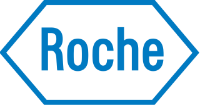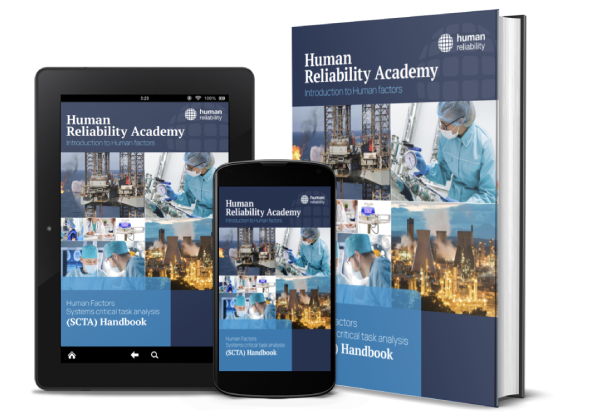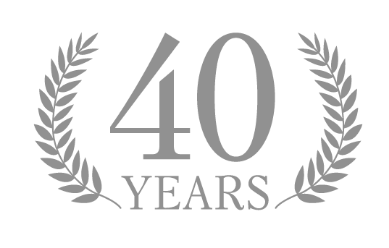In safety-critical industries, Standard Operating Procedures (SOP) are fundamental for maintaining safety, efficiency, and regulatory compliance. These procedures form the backbone of daily operations, outlining step-by-step instructions that guide personnel through task execution. Procedures not only ensure operational integrity and minimize risk but are also key in fostering a safety culture and adhering to regulatory standards.
The Health and Safety Executive (HSE) Human Factors Delivery Guide reinforces importance of well-designed procedures in Control of Major Accident Hazards (COMAH) sites. Topic 4 of the guide, Design and Management of Procedures, outlines key success criteria that sites should aim for.
Some of the success criteria for Topic 4 include:
- A clear written standard for developing and managing COMAH-critical procedures based on relevant good practice (operational, MIT and emergency response).
- Clear links between procedures and local MAH scenarios and written procedures are available for the full range of COMAH-critical tasks.
- Used on-plant task analysis to inform the step-by-step content of COMAH-critical procedures to define the agreed way of conducting relevant tasks in a safe manner.
- Identified critical steps clearly, and appropriate warning information is given in the correct place, helping define a ‘human basis of safety’ for tasks where reliance is placed on people as part of the necessary measures.
- Established a framework to optimise usability of procedures
- Established a structured framework to train and assess personnel in new or updated procedures.
When implemented correctly, procedures play a crucial role in reducing the risks of Major Accident Hazards (MAH) scenarios. However, for a procedure to be truly effective, it must have a right balance between quality content and usability. In this blog, we will demonstrate how we can produce an effective procedure focusing on content and usability.
*The blog is part of our Procedures series. The first blog compiled some examples of best practices in procedures development while the second blog discusses elements that enhances the value of the procedure.
Ensuring High-Quality Content in Procedures
One of the essential components of an effective procedure is its content. The procedure must be accurate, clear, and well-structured. Each step should include the right level of detail and be easily understood by the user. One way to ensure this is by utilising the Hierarchical Task Analysis (HTA) method to break down tasks into manageable components.
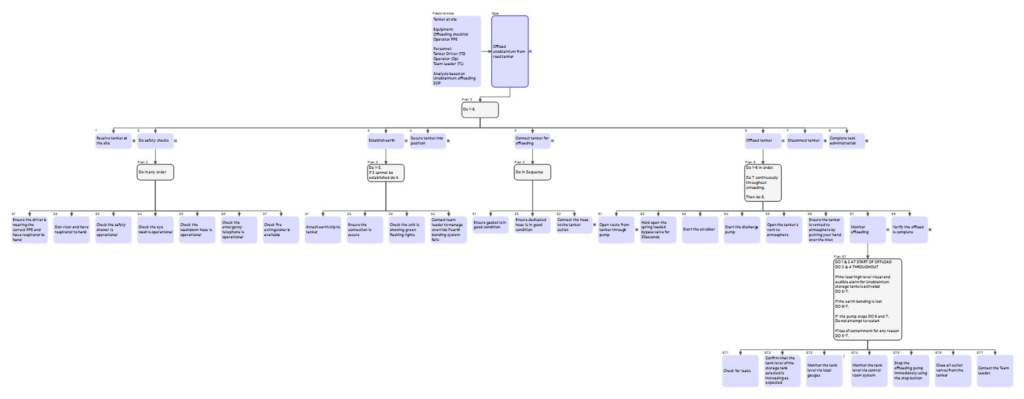
HTA is a Human Factors analysis tool that graphically maps out tasks by breaking them down into smaller, digestible chunks. This approach helps analysts understand the task more effectively and identify areas that need clarification. HTAs can be developed from existing procedures or created from scratch and are often used as the basis for Safety Critical Task Analysis (SCTA) workshops with clients.
Once the HTA is constructed, we can start thinking about whether the HTA constructed (Work-as-Imagined or WAI) accurately reflects how the task is performed (Work-as-Done or WAD). Typically during an SCTA workshop, we collaborate with relevant personnel to ensure that the HTA accurately reflects real-world task execution. Addressing any discrepancies between WAI and WAD is crucial for mitigating operational inefficiencies and reducing the likelihood of unwanted incidents.
Another important consideration when discussing the HTA is the identification of critical steps and their link to the relevant MAH scenarios. By highlighting these critical steps, we ensure extra focus and attention is given to these steps during the SCTA workshop. Moreover, we can use the HTA to include any critical warnings. These elements elevate the quality of the procedure by making it more risk-informed, which is in line with the success criteria set within the HF Delivery Guide.
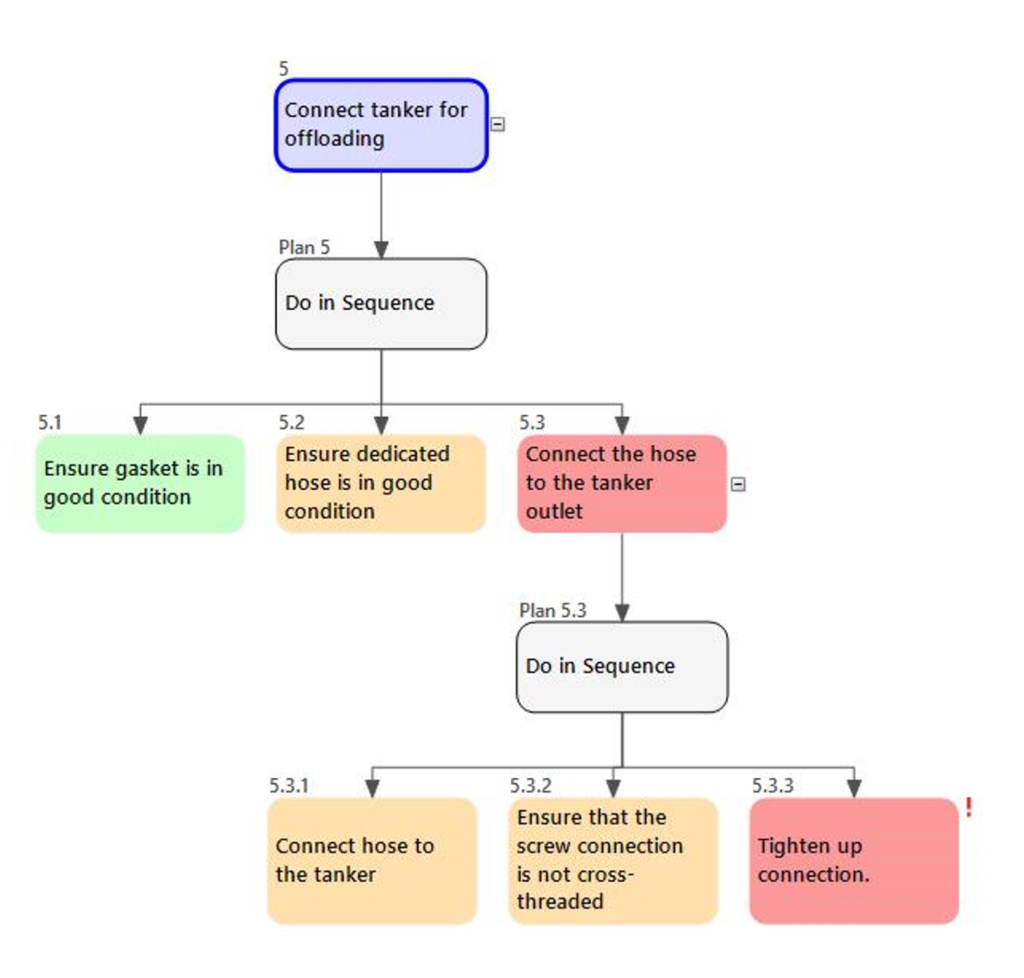
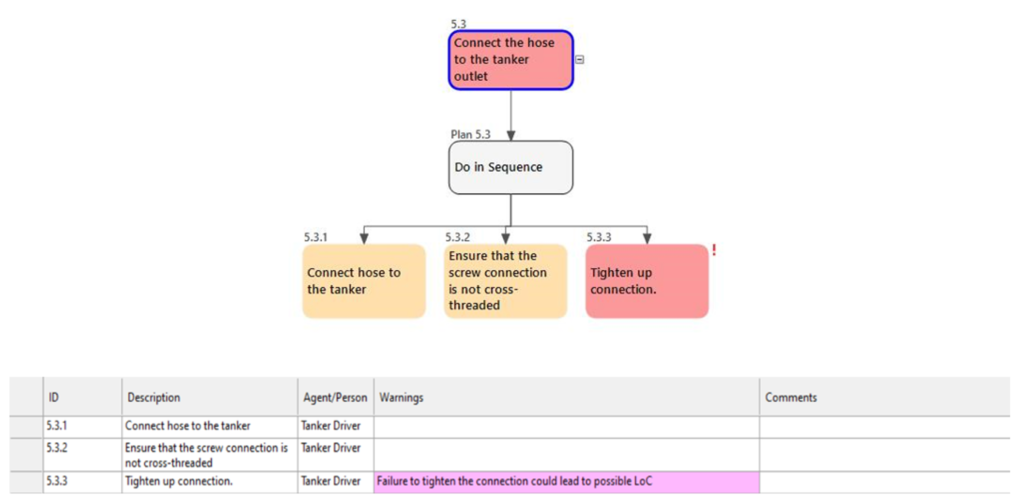
Once the HTA and SCTA review is complete, we can use the review results to create a revised SOP. This offers several benefits as the discussion from the SCTA workshop would have:
- Ensure that the procedures mirror actual task execution.
- Identified and highlighted safety-critical steps.
- Incorporated key information linking to specific MAH scenarios
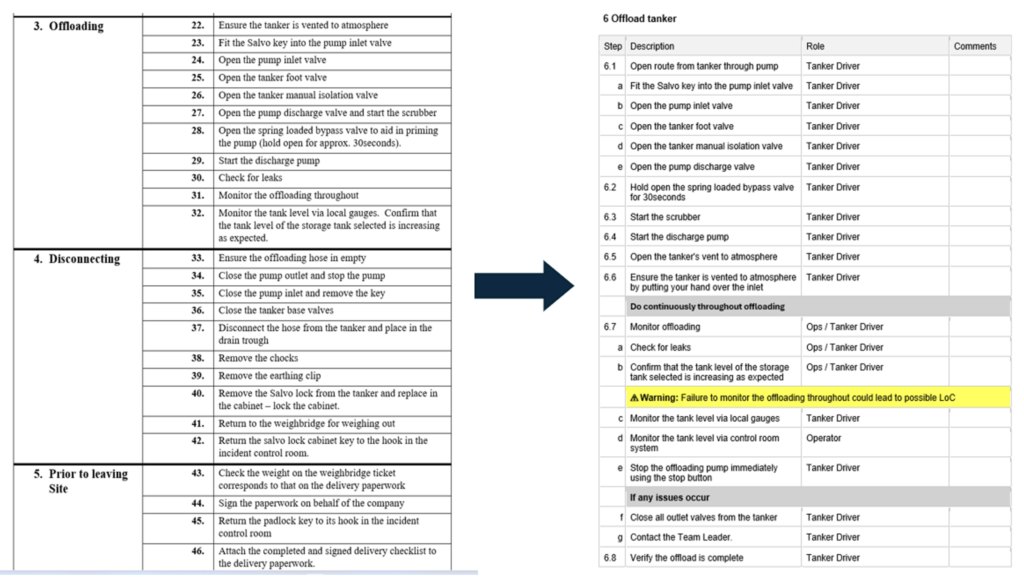
The image above compares the original SOP for offloading a road tanker (left) and the revised version created using SHERPA (right). In the updated SOP, the steps are presented in a clear, defined manner. They are also separated into dedicated rows, reducing the chances of missing out on some steps. Additionally, new elements such as Warnings, Comments, and Roles were added, making the SOP more informational and educational for the reader. Plans were also introduced where appropriate to guide users when conducting the task.
Enhancing Usability in Procedures
While well-defined and informative procedures are crucial for maintaining safety and efficiency, their usability is just as important. How a procedure is presented can significantly impact a user’s ability to understand and follow the task. Poor formatting can lead to confusion, making it challenging to understand the task.
We generated the revised SOP using one of the existing procedure templates within our SHERPA software. This revised SOP had several formatting changes to enhance the usability of the procedure. For example, we reduced the intensity of the borders within the document to improve readability. We also incorporated contrasting colours, such as yellow and black for Warnings, to ensure critical information is not lost within the procedure. Different shades of grey were used to denote varying levels of information, creating a more intuitive flow.
However, usability goes beyond formatting. It is also essential to address whether the procedure suits the user requirements. While step-by-step procedures are often used for safety-critical tasks, some tasks, particularly routine ones performed by experienced personnel, may benefit from abridged procedures or checklists. In such cases, other types of support, such as an abridged version of the procedure or a checklist, might be more fitting. On the other hand, competency-based procedures may be more appropriate for new personnel, offering a more detailed and supportive approach.
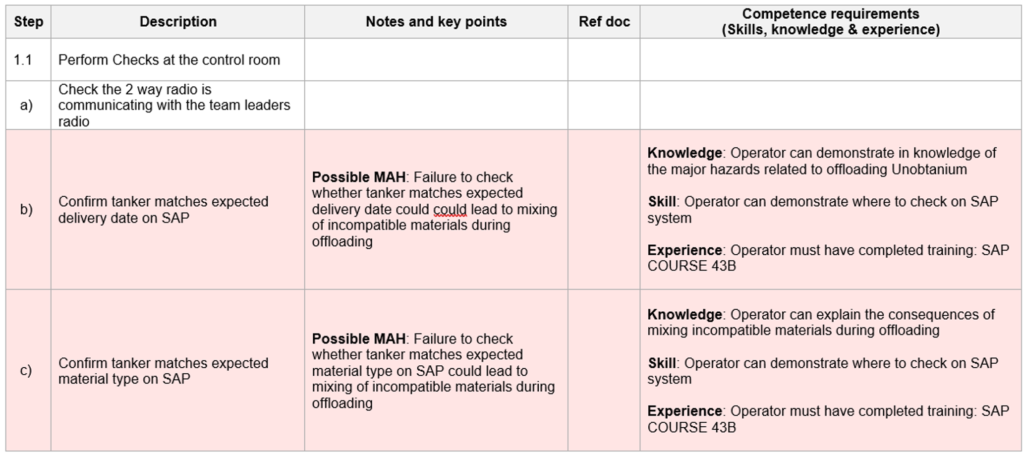
Organizations can also enhance usability by incorporating sign-off boxes within the procedure, prompting operators to actively engage with the task. This not only helps ensure that steps are followed but also serves as a record of competence.
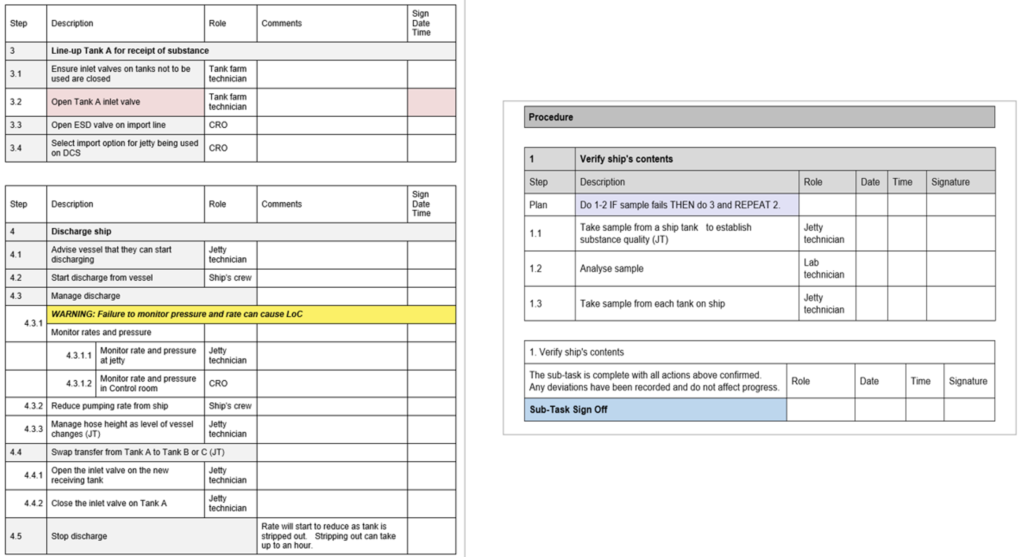
While improving the formatting of procedures adds significant value to usability, we understand that the process can be both time-consuming and complex. The SHERPA software simplifies this by automatically generating well-informed procedures directly from the HTA. With just a click, SHERPA allows you to create procedures using one of its many built-in templates or a custom template tailored to your specific needs. This automation not only streamlines the process but ensures that your procedures are comprehensive, clear, and user-friendly.
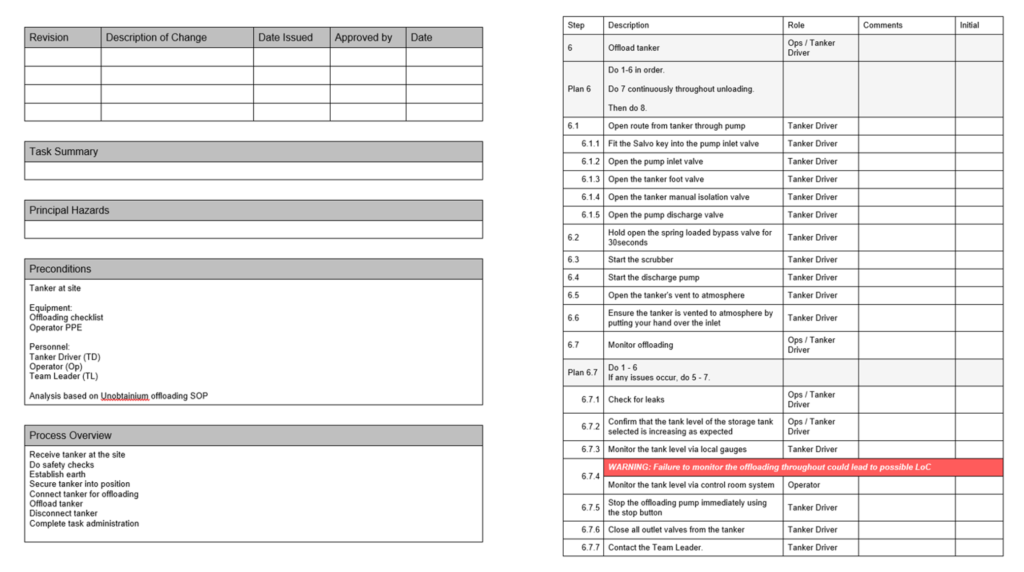
Conclusion
In safety-critical industries, procedures that are both content-rich and user-friendly can add value in mitigating risks, enhancing safety, and ensuring overall smooth operations. The HSE Human Factors Delivery Guide highlights the need for not only accurate and comprehensive procedural content but also a focus on usability. This further drives home the point that procedures are not just regulatory tools, but that they are essential in safeguarding against MAH by ensuring that tasks are performed consistently, safely and effectively.
If you would like to see how the SHERPA software can support you in your overall SCTA program and generate risk-informed procedures, please get in touch to find out more.
The HSE Procedures Audit Tool is a great exercise for reviewing the format of your procedures. But, if you’d like further support with reviewing your procedures, please get in touch with our Human Factors consultants.


